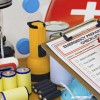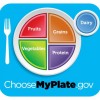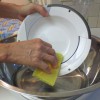 People in Florida might not consider planning and preparing for winter weather events because of its normally mild temperatures. However, some northern Florida regions experience temperatures below freezing and occasional snow and ice storms during the winter months. These storm events can be dangerous and even deadly. These simple safety reminders can help you and your family be better prepared for Florida’s winter weather events. This 3-page fact sheet was written by Randall Cantrell, Judy Corbus, and Michael Spranger, and published by the UF Department of Family Youth and Community Sciences, April 2014.
People in Florida might not consider planning and preparing for winter weather events because of its normally mild temperatures. However, some northern Florida regions experience temperatures below freezing and occasional snow and ice storms during the winter months. These storm events can be dangerous and even deadly. These simple safety reminders can help you and your family be better prepared for Florida’s winter weather events. This 3-page fact sheet was written by Randall Cantrell, Judy Corbus, and Michael Spranger, and published by the UF Department of Family Youth and Community Sciences, April 2014.
http://edis.ifas.ufl.edu/fy1407
Tag: Family Youth and Community Sciences Department
An Introduction to Annuities
 An annuity contract is purchased from a life insurance company. The individual gives the insurance company a lump-sum payment or a series of payments. In return, the company will provide a stream of payments to the individual. Although an annuity is purchased from a life insurance company, it serves a different purpose than life insurance. Below is a chart comparing life insurance to annuities.
An annuity contract is purchased from a life insurance company. The individual gives the insurance company a lump-sum payment or a series of payments. In return, the company will provide a stream of payments to the individual. Although an annuity is purchased from a life insurance company, it serves a different purpose than life insurance. Below is a chart comparing life insurance to annuities.
This 4-page fact sheet was written by Michael S. Gutter and Lisa Leslie, and published by the UF Department of Family Youth and Community Sciences, March 2014.
http://edis.ifas.ufl.edu/fy1406
Healthy Living: Food Can Affect Your Medicines
 Do the foods you eat affect the way your medicines work? It’s very possible. Certain foods can affect the way prescription and over-the-counter medicines work by delaying, decreasing, or enhancing how much of the drug is absorbed by the body. This can cause unwanted and harmful side effects. Follow the information in this 2-page fact sheet to reduce your risk of common food and drug interactions. Written by Paulina Wittkowsky and Linda B. Bobroff, and published by the UF Department of Family Youth and Community Sciences, May 2014.
Do the foods you eat affect the way your medicines work? It’s very possible. Certain foods can affect the way prescription and over-the-counter medicines work by delaying, decreasing, or enhancing how much of the drug is absorbed by the body. This can cause unwanted and harmful side effects. Follow the information in this 2-page fact sheet to reduce your risk of common food and drug interactions. Written by Paulina Wittkowsky and Linda B. Bobroff, and published by the UF Department of Family Youth and Community Sciences, May 2014.
http://edis.ifas.ufl.edu/fy676
MyPlate “10 Tips” Nutrition Education series
 After introducing MyPlate in June 2011, USDA provided a series of one-page fact sheets to help consumers use the dietary advice of the Dietary Guidelines 2010. The USDA added new fact sheets in December 2011 and continued adding fact sheets in 2012, 2013, and 2014. These fact sheets are distributed by UF/IFAS Extension for Extension faculty, health professionals, and consumers. They are also called the “Ten Tips Nutrition Education Series” and “DG TipSheets”
After introducing MyPlate in June 2011, USDA provided a series of one-page fact sheets to help consumers use the dietary advice of the Dietary Guidelines 2010. The USDA added new fact sheets in December 2011 and continued adding fact sheets in 2012, 2013, and 2014. These fact sheets are distributed by UF/IFAS Extension for Extension faculty, health professionals, and consumers. They are also called the “Ten Tips Nutrition Education Series” and “DG TipSheets”
New in 2014:
- 32. Make Healthier Holiday Choices
- 33. Men’s Health: Get the Facts to Feel and Look Better
- 34. Teen Guys: Choose the Foods You Need To Grow
- 35. Women’s Health: Make Better Food Choices
- 36. Teen Girls: Eat Smart and Be Active As You Grow
- 37. Save More at the Grocery Store
http://edis.ifas.ufl.edu/topic_myplate_nutrition_education_series
Raising Healthy Children: Age Four
 As children continue their preschool years, they learn many new things and develop their own opinions and ideas. During this time, people inside and outside of the home may greatly influence them. As preschoolers continue to learn and grow, caregivers can take many steps to guide their children in a healthy and positive direction. This 4-page fact sheet was written by Kate Bennet, Gail Kauwell, and Karla P. Shelnutt, and published by the UF Department of Family Youth and Community Sciences, April 2014.
As children continue their preschool years, they learn many new things and develop their own opinions and ideas. During this time, people inside and outside of the home may greatly influence them. As preschoolers continue to learn and grow, caregivers can take many steps to guide their children in a healthy and positive direction. This 4-page fact sheet was written by Kate Bennet, Gail Kauwell, and Karla P. Shelnutt, and published by the UF Department of Family Youth and Community Sciences, April 2014.
http://edis.ifas.ufl.edu/fy1398
Five Steps to Seasonal Savings
 When the holiday season is over you may find yourself saying: “Why did I spend all of that money? Why did I wait until the last minute to shop? I don’t even want to think about how long it will take to pay off the credit cards. I hope I didn’t take too much money out of the ATM. Did I buy my mom the same gift twice? I should have had a plan.” By following a few simple steps, you can end this post-holiday hangover. This 5-page fact sheet was written by Ricki McWilliams, Julie Pigott-Dillard, and Michael Gutter, and published by the UF Department of Family Youth and Community Sciences, January 2014.
When the holiday season is over you may find yourself saying: “Why did I spend all of that money? Why did I wait until the last minute to shop? I don’t even want to think about how long it will take to pay off the credit cards. I hope I didn’t take too much money out of the ATM. Did I buy my mom the same gift twice? I should have had a plan.” By following a few simple steps, you can end this post-holiday hangover. This 5-page fact sheet was written by Ricki McWilliams, Julie Pigott-Dillard, and Michael Gutter, and published by the UF Department of Family Youth and Community Sciences, January 2014.
http://edis.ifas.ufl.edu/fy1405
Facts about Vitamin D
 Vitamin D is needed for normal absorption of calcium and phosphorus. It helps put these minerals into bones and teeth. This makes bones stronger and reduces risk for bone fractures. Vitamin D also helps keep the immune system functioning normally, so our bodies can resist some types of disease. This 2-page fact sheet was written by Linda B. Bobroff and Isabel Valentín-Oquendo, and published by the UF Department of Family Youth and Community Sciences, February 2014.
Vitamin D is needed for normal absorption of calcium and phosphorus. It helps put these minerals into bones and teeth. This makes bones stronger and reduces risk for bone fractures. Vitamin D also helps keep the immune system functioning normally, so our bodies can resist some types of disease. This 2-page fact sheet was written by Linda B. Bobroff and Isabel Valentín-Oquendo, and published by the UF Department of Family Youth and Community Sciences, February 2014.
http://edis.ifas.ufl.edu/fy207
Food Safety: High Risk Foods Crossword
 Some foods are more likely to cause foodborne illness than others. Unpasteurized milk or juices are not safe to consume. Uncooked foods that are made with raw or undercooked eggs are especially risky. This 2-page fact sheet was written by Linda B. Bobroff and Jennifer Hillan, and published by the UF Department of Family Youth and Community Sciences, February 2014.
Some foods are more likely to cause foodborne illness than others. Unpasteurized milk or juices are not safe to consume. Uncooked foods that are made with raw or undercooked eggs are especially risky. This 2-page fact sheet was written by Linda B. Bobroff and Jennifer Hillan, and published by the UF Department of Family Youth and Community Sciences, February 2014.
http://edis.ifas.ufl.edu/fy927
Working in Groups: Facilitating Positive Group Interactions
 Working together in groups can be a great experience or one filled with stress and anxiety. The goal of facilitating positive group interaction is for every group member to contribute in a more positive and productive manner. This article will review several methods that can facilitate positive group interactions, which will also enhance communication and overall group work. This 3-page fact sheet was written by Bryan D. Terry, and published by the UF Department of Family Youth and Community Sciences, October 2013.
Working together in groups can be a great experience or one filled with stress and anxiety. The goal of facilitating positive group interaction is for every group member to contribute in a more positive and productive manner. This article will review several methods that can facilitate positive group interactions, which will also enhance communication and overall group work. This 3-page fact sheet was written by Bryan D. Terry, and published by the UF Department of Family Youth and Community Sciences, October 2013.
http://edis.ifas.ufl.edu/fy1377
Safe Dishwashing Without an Automatic Dishwasher for Home, Community Events, and Outdoor Activities
 Most of us are accustomed to the ease and convenience of washing our dishes in an automatic dishwasher. At times, however, no dishwasher is available. This 4-page fact sheet teaches ways to safely wash or clean your dishes by hand, which may be necessary when your dishwasher is broken, you are outdoors, or you are working in a facility without a dishwasher. Written by Morgan Denhard, Amy Simonne, and Ricki McWilliams, and published by the UF Department of Family Youth and Community Sciences, December 2014.
Most of us are accustomed to the ease and convenience of washing our dishes in an automatic dishwasher. At times, however, no dishwasher is available. This 4-page fact sheet teaches ways to safely wash or clean your dishes by hand, which may be necessary when your dishwasher is broken, you are outdoors, or you are working in a facility without a dishwasher. Written by Morgan Denhard, Amy Simonne, and Ricki McWilliams, and published by the UF Department of Family Youth and Community Sciences, December 2014.
http://edis.ifas.ufl.edu/fy1403
Raising Healthy Children: Promoting a Positive Feeding Experience
 All parents have heard “I don’t like that!” or “I’m not hungry!” from their child at some point or another. It’s likely that your child will not like every food that is served, but that doesn’t mean mealtime can’t still be a pleasant experience for the family. Parents may think they have sole responsibility for their child’s food choices, but Ellyn Satter, a registered dietitian who specializes in feeding and eating, advises that young children also have responsibility in the eating process. If feeding your child is stressful, read this fact sheet to learn about the division of responsibility in feeding and how to make meal times more enjoyable for the whole family. This 3-page fact sheet was written by Tiffany N. Stodtko, Karla P. Shelnutt, and Gail P.A. Kauwell, and published by the UF Department of Family Youth and Community Sciences, December 2014.
All parents have heard “I don’t like that!” or “I’m not hungry!” from their child at some point or another. It’s likely that your child will not like every food that is served, but that doesn’t mean mealtime can’t still be a pleasant experience for the family. Parents may think they have sole responsibility for their child’s food choices, but Ellyn Satter, a registered dietitian who specializes in feeding and eating, advises that young children also have responsibility in the eating process. If feeding your child is stressful, read this fact sheet to learn about the division of responsibility in feeding and how to make meal times more enjoyable for the whole family. This 3-page fact sheet was written by Tiffany N. Stodtko, Karla P. Shelnutt, and Gail P.A. Kauwell, and published by the UF Department of Family Youth and Community Sciences, December 2014.
http://edis.ifas.ufl.edu/fy1397
Important Things to Know about Medicare series
 As an older adult citizen of the United States, it is important to understand the structure of Medicare and how it affects you. The information in this series is based on the most current data available and includes several changes with the implementation of the Affordable Care Act. This guide was also written using Florida guidelines when appropriate. Please bear in mind that your personal situation may vary from the examples in the series, and always contact your local Medicare representative for questions regarding your own circumstances.
As an older adult citizen of the United States, it is important to understand the structure of Medicare and how it affects you. The information in this series is based on the most current data available and includes several changes with the implementation of the Affordable Care Act. This guide was also written using Florida guidelines when appropriate. Please bear in mind that your personal situation may vary from the examples in the series, and always contact your local Medicare representative for questions regarding your own circumstances.
- Introduction and Overview
- Chapter One–Who Is Eligible for Medicare, and Do I Have To Sign Up for It?
- Chapter Two: Medicare Part A–Hospital Insurance
- Chapter Three: Medicare Part B–Medical Insurance
- Chapter Four–Medicare Part C – Medicare Advantage
- Chapter Five–Medicare Part D–Prescription Drug Coverage
- Chapter Six–“Medigap” Policies
- Chapter Seven–How does my other insurance work with Medicare? Who pays first?
- Chapter Eight–What if I need help paying my health care and prescription drug costs?
- Chapter Nine–How should I decide how I want to get my Medicare?
- Chapter Ten–Key Terms, Additional Resources, List of Handouts, and References
Written by Amanda Terminello and Martie Gillen, and published by the UF Department of Family Youth and Community Sciences, September 2013.
http://edis.ifas.ufl.edu/topic_series_important_things_to_know_about_medicare
Working in Groups: The Importance of Communication in Developing Trust and Cooperation
 Working together in groups can be a great experience or one filled with stress and anxiety. The success of group work depends largely on the trust developed among group members and the respect they show each other. When an individual has had a positive experience in a group, he/she is more likely to take risks, ask questions, and share ideas that will benefit the total group. This 3-page fact sheet was written by Bryan D. Terry, and published by the UF Department of Family Youth and Community Sciences, August 2013.
Working together in groups can be a great experience or one filled with stress and anxiety. The success of group work depends largely on the trust developed among group members and the respect they show each other. When an individual has had a positive experience in a group, he/she is more likely to take risks, ask questions, and share ideas that will benefit the total group. This 3-page fact sheet was written by Bryan D. Terry, and published by the UF Department of Family Youth and Community Sciences, August 2013.
http://edis.ifas.ufl.edu/fy1378
A Consumer's Guide to Eggs
 People have been eating eggs for centuries. Records as far back as 1400 BC show that the Chinese and Egyptians raised birds for their eggs. The first domesticated birds to reach the Americas arrived in 1493 on Christopher Columbus' second voyage to the New World. Most food stores in the United States offer many varieties of chicken eggs to choose from — white, brown, organic, cage free, vegetarian, omega-3 fatty acid enriched, and more. The bottom line is that buying eggs is not as simple as it used to be because more choices exist today. This 4-page fact sheet will help you understand the choices you have as a consumer, so you can determine which variety of egg suits you and your family best. Written by Jeanine Beatty, Karla Shelnutt, and Gail Kauwell, and published by the UF Department of Family Youth and Community Sciences, April 2013.
People have been eating eggs for centuries. Records as far back as 1400 BC show that the Chinese and Egyptians raised birds for their eggs. The first domesticated birds to reach the Americas arrived in 1493 on Christopher Columbus' second voyage to the New World. Most food stores in the United States offer many varieties of chicken eggs to choose from — white, brown, organic, cage free, vegetarian, omega-3 fatty acid enriched, and more. The bottom line is that buying eggs is not as simple as it used to be because more choices exist today. This 4-page fact sheet will help you understand the choices you have as a consumer, so you can determine which variety of egg suits you and your family best. Written by Jeanine Beatty, Karla Shelnutt, and Gail Kauwell, and published by the UF Department of Family Youth and Community Sciences, April 2013.
http://edis.ifas.ufl.edu/fy1357
Managing Stress During the Holidays
 When we think of the holidays, we often think about family, togetherness, giving, and celebrating. While the holiday season should be a time of enjoyment, there are many events associated with the season that can cause stress. This 3-page fact sheet was written by Heidi Radunovich, and published by the UF Department of Family Youth and Community Sciences, November 2013.
When we think of the holidays, we often think about family, togetherness, giving, and celebrating. While the holiday season should be a time of enjoyment, there are many events associated with the season that can cause stress. This 3-page fact sheet was written by Heidi Radunovich, and published by the UF Department of Family Youth and Community Sciences, November 2013.
http://edis.ifas.ufl.edu/fy1404
Home Gardening Food Safety: Washing the Fruits (and Vegetables) of Your Labor Properly
 Having a home garden has become popular recently. It is a great way to enjoy fresh fruits and vegetables—foods that are an important part of a healthy diet. However, just because you have your own garden and control how it is treated does not make the fruits and vegetables you grow safer than those you buy in the store. To reduce the chance of getting sick from foodborne illnesses, you must wash the fruits and vegetables you grow before eating them raw or cooked. This publication helps you learn the proper way to clean your fruits and vegetables so you can enjoy them safely. This 4-page fact sheet was written by Eshani Persaud, Amy Simonne, and Karla P. Shelnutt, and published by the UF Department of Family Youth and Community Sciences, November 2013.
Having a home garden has become popular recently. It is a great way to enjoy fresh fruits and vegetables—foods that are an important part of a healthy diet. However, just because you have your own garden and control how it is treated does not make the fruits and vegetables you grow safer than those you buy in the store. To reduce the chance of getting sick from foodborne illnesses, you must wash the fruits and vegetables you grow before eating them raw or cooked. This publication helps you learn the proper way to clean your fruits and vegetables so you can enjoy them safely. This 4-page fact sheet was written by Eshani Persaud, Amy Simonne, and Karla P. Shelnutt, and published by the UF Department of Family Youth and Community Sciences, November 2013.
http://edis.ifas.ufl.edu/fy1401
The Facts About Applying: Health Care Coverage and the Affordable Care Act
 President Obama signed the Affordable Care Act into law in March 2010, putting in place a set of reforms to health coverage in the United States. For Americans who have health insurance, they do not have to change their current plan under the health care law. However, those who do not have coverage will have the chance to shop for health insurance starting October 1 using the new Health Insurance Marketplace. This publication reviews some common questions about the new health care law and how it will affect citizens. This 3-page fact sheet was written by Meg McAlpine and Martie Gillen, and published by the UF Department of Family Youth and Community Sciences, October 2013.
President Obama signed the Affordable Care Act into law in March 2010, putting in place a set of reforms to health coverage in the United States. For Americans who have health insurance, they do not have to change their current plan under the health care law. However, those who do not have coverage will have the chance to shop for health insurance starting October 1 using the new Health Insurance Marketplace. This publication reviews some common questions about the new health care law and how it will affect citizens. This 3-page fact sheet was written by Meg McAlpine and Martie Gillen, and published by the UF Department of Family Youth and Community Sciences, October 2013.
http://edis.ifas.ufl.edu/fy1394
Choose MyPlate: Enjoy Your Food But Eat Less
 Americans tend to select and consume larger portions than they need, and they don’t always make the best choices either. Part of the secret to maintaining a healthy diet is to know which foods to select and how to balance your intake with the amount of energy your body uses. This publication provides information about which foods make the healthiest contributions to our diets and which to limit. It also provides tips for making it easier to adjust your portions and to enjoy foods while making adjustments to your plate. This 4-page fact sheet was written by Ashley Hamm, Karla P. Shelnutt, and Gail P. A. Kauwell, and published by the UF Department of Family Youth and Community Sciences, November 2013.
Americans tend to select and consume larger portions than they need, and they don’t always make the best choices either. Part of the secret to maintaining a healthy diet is to know which foods to select and how to balance your intake with the amount of energy your body uses. This publication provides information about which foods make the healthiest contributions to our diets and which to limit. It also provides tips for making it easier to adjust your portions and to enjoy foods while making adjustments to your plate. This 4-page fact sheet was written by Ashley Hamm, Karla P. Shelnutt, and Gail P. A. Kauwell, and published by the UF Department of Family Youth and Community Sciences, November 2013.
http://edis.ifas.ufl.edu/fy1400
Healthy Eating: Food Storage Guide
 If you don’t shop for groceries often, you may want to buy food that will last until your next trip to the store. The following storage guidelines for perishable foods will help you decide how much food to buy when you visit the grocery. Keep in mind that safe storage times depend on the condition of the food when you purchase it and your refrigerator temperature and humidity. Check foods often for any signs of spoilage. This 2-page fact sheet was written by Linda B. Bobroff and Jennifer Hillan, and published by the UF Department of Family Youth and Community Sciences, October 2013.
If you don’t shop for groceries often, you may want to buy food that will last until your next trip to the store. The following storage guidelines for perishable foods will help you decide how much food to buy when you visit the grocery. Keep in mind that safe storage times depend on the condition of the food when you purchase it and your refrigerator temperature and humidity. Check foods often for any signs of spoilage. This 2-page fact sheet was written by Linda B. Bobroff and Jennifer Hillan, and published by the UF Department of Family Youth and Community Sciences, October 2013.
http://edis.ifas.ufl.edu/fy699
Healthy Living: Keep Track of Your Blood Pressure
 Every time you take your blood pressure, write down the date and time, the blood pressure measurement, and where it was taken (home, doctor’s office, etc.). Not only that, but include any comments your health care provider made and anything you would like to note, such as how you feel or medications you recently started or stopped. This 2-page fact sheet was written by Linda B. Bobroff and Leigh Ann Martin, and published by the UF Department of Family Youth and Community Sciences, October 2013.
Every time you take your blood pressure, write down the date and time, the blood pressure measurement, and where it was taken (home, doctor’s office, etc.). Not only that, but include any comments your health care provider made and anything you would like to note, such as how you feel or medications you recently started or stopped. This 2-page fact sheet was written by Linda B. Bobroff and Leigh Ann Martin, and published by the UF Department of Family Youth and Community Sciences, October 2013.
http://edis.ifas.ufl.edu/fy662